

Tel Achziv : les fouilles d’une antique cité phénicienne – ArchéOrient – Le Blog. Tel Achziv est situé sur une bordure de grès côtier, localement appelé kurkar, à près de 14 km au nord de Saint-Jean d’Acre et à 25 km au sud de Tyr (fig. 1).

Le tel se trouve sur un promontoire bordé par les estuaires de deux rivières à écoulement non pérenne : au nord le Nahal Keziv et au sud le Nahal Sha’al (fig. 2). On doit à Eusèbe de Césarée (Onomasticon XXX, 12) d’avoir reconnu dans l’Achziv biblique (Josué 19, 29 ; Juges 1, 31) l’Ekdippa mentionné auparavant chez Flavius Josèphe comme une ville maritime (La guerre des juifs I, XIII, 42) et à l’érudit H. Maundrell le rapprochement d’Ekdippa avec la localité de Zib, qu’il traverse lors de son voyage d’Alep à Jérusalem en 1697 (Maundrell 1823 : 46).
Le village palestinien d’ez-Zib, situé sur le sommet du tel archéologique, conservera ce nom jusqu’en 1948. Fig. 3 : les sites phéniciens du Levant (Stern 2001 : 59). Tel Achziv a fait l’objet de fouilles entre 1941 et 1944 par I. Neuf autres campagnes de fouilles dirigées par M. Docs - Michael Langlois. Here are documents, files and resources you may want to download.

Keyboards I created keyboards to input ancient scripts using a French AZERTY keyboard. Home. Revue de Qumrân was founded by Jean Carmignac in 1958.
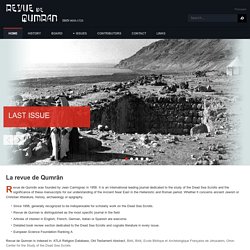
It is an International leading journal dedicated to the study of the Dead Sea Scrolls and the significance of these manuscripts for our understanding of the Ancient Near East in the Hellenistic and Roman period. Whether it concerns ancient Jewish or Christian litterature, history, archaeology or epigraphy. Since 1958, generally recognized to be indispensable for scholarly work on the Dead Sea Scrolls. Revue de Qumran is distinguished as the most specific journal in the field Articles of interest in English, French, German, italian or Spanish are welcome.
Detailed book review section dedicated to the Dead Sea Scrolls and cognate literature in every issue. Featured articles. Archaeological Excavations in Israel 2016. This list of archaeological expeditions which accept volunteers is compiled by the Israel Foreign Ministry as a service to the public, and is not an endorsement of any of the projects listed.
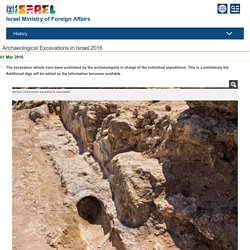
The excavation details below been published by the archaeologists in charge of the individual expeditions, who bear responsibility for their contents. NOTE: Any questions, comments or requests for additional information must be directed to the contact person indicated for each project, and not to the Israel Foreign Ministry. Many archaeologists enlist volunteer help on their digs, as volunteers are highly motivated and wish to learn and gain experience, although the work is often difficult and tedious. Archaeological Excavations in Israel 2016. Volunteers Find Missing Pieces to Looted Inscription. Volunteers Find Missing Pieces to Looted Inscription Examination of the stela and its inscription by experts secured its authenticity, but its provenance remained unknown.
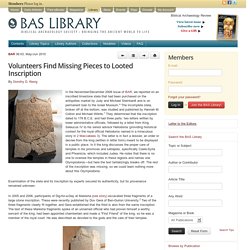
In 2005 and 2006, participants of Dig-for-a-Day at Maresha (see story) excavated three fragments of a large stone inscription. These were recently published by Dov Gera of Ben-Gurion University.2 Two of the three fragments clearly fit together, and Gera established that the third is also from the same inscription. The text of these Maresha fragments spoke of an unnamed official who had proven himself a worthy servant of the king, had been appointed chamberlain and made a “First Friend” of the king, so he was a member of the royal court.
He was described as devoted to the gods and the care of their temples. Archaeological Seminars. Archaeological Seminars Institute is a private company based in Jerusalem, Israel that deals with archaeology and tourism.

Founded in 1981 by archaeologist Bernie Alpert and his wife, Fran Alpert, as an educational tourist facility and joined in 1985 by archaeologist Dr. Ian Stern. Archaeological Seminars Institute runs the “Dig for a Day” program in Beit Guvrin and hires out licensed tour guides for private walking tours. The company also ran an official English-language tour guide course for ten years.
Beit Guvrin, Israel. Beit Guvrin (Hebrew: בֵּית גֻּבְרִין, lit.
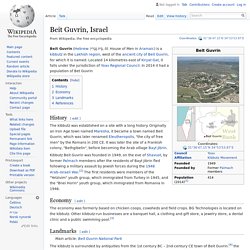
House of Men in Aramaic) is a kibbutz in the Lakhish region, west of the ancient city of Beit Guvrin, for which it is named. Located 14 kilometres east of Kiryat Gat, it falls under the jurisdiction of Yoav Regional Council. In 2014 it had a population of Bet Guvrin History[edit] Maresha. For the history of the site see in chronological order Maresha, Beit Guvrin, Eleutheropolis, Bethgibelin, Bayt Jibrin, Kibbutz Beit Guvrin and Beit Guvrin National Park Tel Maresha (Hebrew: תל מראשה), also Marissa (ماريسا the Arabized form),[1] is an antiquity site in Israel's southern lowlands.
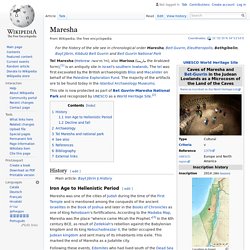
The tel was first excavated by the British archaeologists Bliss and Macalister on behalf of the Palestine Exploration Fund. The majority of the artifacts are to be found today in the Istanbul Archaeology Museums. This site is now protected as part of Bet Guvrin-Maresha National Park and recognized by UNESCO as a World Heritage Site.[2] History[edit] Iron Age to Hellenistic Period[edit] The Dead Sea Scrolls.